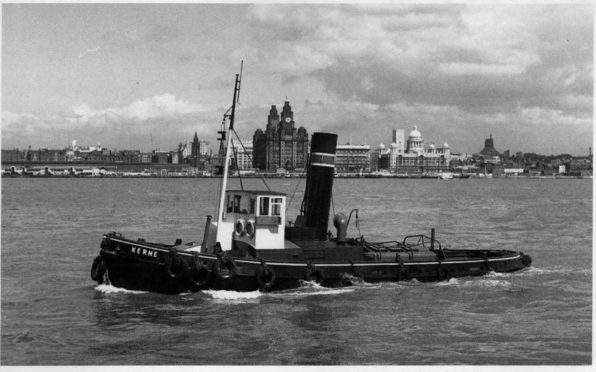The story of a Montrose-built steam tug boat’s wartime adventures will be told to a new generation.
The Kerne is believed to be the only ship afloat driven by steam that served the Royal Navy in both world wars.
The Steam Tug Kerne Preservation Society has now been granted an award of £9,300 by The Heritage Lottery Fund under the ‘First World War: then and now’ scheme.
Young people will also be trained in rare heritage boiler repair skills while replacement work will also be taking place to enable her to continue to steam to events.
The Heritage Lottery Fund’s small grants programme has been making at least £1m available per year for six years until 2019 to help communities mark the centenary of the first world war.
A spokesman for the preservation society said: “As HM Tug Terrier she served the Royal Navy from 1913 until being sold into civilian service at Liverpool in 1948.
“Boiler stay tubes will be replaced in the Royal Navy Chatham Dockyard built boiler to enable her to steam to events as the last surviving operational ex-Royal Navy steamship from the first world war.
“The work will be led by our skilled volunteers who will train young people in rare heritage boiler repair skills.
“The award will go towards researching and sharing the First World War heritage of Kerne, tell the story of her role in the naval dockyards, commemorate those who served in HM tugs and enable visitors to visit Kerne at events and see what life was like aboard a ex-Royal Navy coal fired steamship.”
In recognition of her increasing historical importance, Kerne is now part of the Historic Fleet as designated by National Historic Ships.
In March 1912 Winston Churchill, who was then First Sea Lord, ordered the return of the three complete Mediterranean Fleets from the dockyards at Gibraltar and Malta to protect the North Sea in case of war with Germany.
The French Navy was left to guard the Mediterranean Sea.
The return of the fleets put additional strain on Chatham and Sheerness Dockyards to service them.
Churchill’s order resulted in additional tugs and service craft being urgently required.
Built by Montrose Shipbuilding Co Ltd and completed in 1913 to fulfil an order placed by the Gerdes-Hansen and Co, she was originally named Viking.
Upon completion in March 1913, she sailed under her own power to London but in April 1913 was acquired by the Admiralty and renamed Terrier.
Based in Chatham, she worked in and around the Medway as a harbour/basin tug for 35 years, which included the two world wars.
It was sold out of naval service in March 1948 to JP Knight and renamed Kerne, which is Gaelic for ‘vagabond foot soldier’.
In September 1949 it was sold on to the Straits Steamship Company of Liverpool, sailing north to work on the Mersey, Manchester Ship Canal and Weaver Navigation as a lighterage tug until its retirement in March 1971.
The Kerne was about to go for scrap when a group of enthusiasts outbid the scrapman and paid £25 to rescue her from the cutter’s torch.
Its greatest honour was to represent its type in the royal review of ships on the Mersey during the Queen’s silver jubilee in 1977.
The Kerne is owned by the North Western Steamship Company Ltd but is operated by the preservation society.










